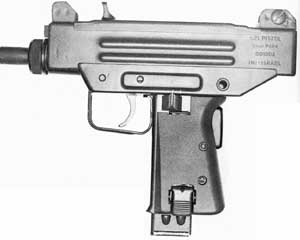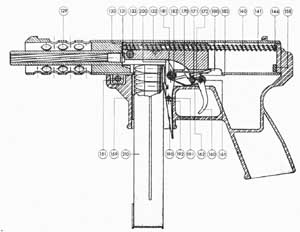Nation of origin: Israel
Ammunition: 9 x 19 mm
Operation: blowback
Weight: loaded, 2.14 kg
Length: 240 mm
Length of barrel: 115mm
Magazine capacity: 20 rounds
Muzzle velocity: approx 350 m/s
The Israeli Uzi pistol is certainly one of the more unusual- looking pistols to be found anywhere today, for although it is meant to be a semi-automatic pistol for use as a personal side arm, it has obvious affinities with the Uzi sub-machine gun from which it was developed. For the Israelis, the Uzi sub-machine gun has become something of a symbol of their past success in fighting off threats to their national existence, and so successful is the Uzi that it has been sold widely to many armed and security forces all around the world, including the West German armed forces.
Bearing in mind that Israel is a small nation with limited production and human resources, it was a natural process that the basic Uzi should be worked upon to produce new weapon designs. One of the first of these was the Mini-Uzi which was a scaled down version of the standard Uzi, followed by the even smaller Micro-Uzi. Both are 9 mm Parabellum models intended for use by special forces or security guards. These designs remain ed sub-machine guns, despite their small dimensions (although some pedants would prefer to call them machine pistols), and it was not until the Uzi Pistol appeared during the mid-1980s that the scaling-down process produced a weapon that could be placed in the true pistol category. Even so, the Uzi Pistol is still a bulky and heavy design, compared to most of its con temporaries.
The Uzi pistol was designed to meet a requirement for a weapon to act as a self-defense measure for Israeli civilians, although no definite announcement appears to have been made. The possibility of guerrilla attack on Israeli settlers in locations such as the West Bank and the northern border areas of Israel has been present for many years. Attacks have materialized in many forms over the years, and large numbers of Israeli settlers understandably feel themselves constantly under threat. They have accordingly called for arms with which to defend themselves, rather than having to rely upon the often hard- pressed regular security forces. Some of the settlers’ demands have been met by the issuing of all manner of small arms, or by the settlers arming themselves, but since most of the weapons involved had to be imported, the Israeli government attempted to produce something locally to conserve limited foreign exchange funds. The Uzi Pistol has been one result.
Despite its bulk and seemingly awkward appearance, the Uzi Pistol is well suited to the civilian defense role. One important point is that it is immediately familiar to most potential users. Nearly every adult Israeli, male and female, has handled and fired the Uzi sub-machine gun during their periods of national service, so handling the Uzi Pistol should present no problems. The Uzi Pistol can also be produced within Israel using existing machinery and other resources, and it makes few demands on expensive raw materials since most of the construction uses simple sheet steel or other ‘non-strategic’ metals and plastics. Manufacture is straightforward, involving a minimum of costly machining processes.
The Uzi Pistol is immensely strong. The weight and bulk of the weapon means that it is capable of taking all manner of knocks and still keep on working. Thus it is an ideal weapon for carrying around in the dust, mud and rain of border Settlements, rattling about in vehicles such as tractors, being left around in a state of ‘benign neglect’ and exposed to all manner of weather conditions for long periods. It is also an ideal weapon to be carried on the long and repetitive guard duties that many outlying settlements have to conduct. One further point in the Uzi Pistol’s favor is that it fires the readily-available 9 mm Parabellum cartridge, already in large-scale production inside Israel. Maintenance is no great problem, since there are only seven parts involved in field stripping.
The Uzi Pistol is not a machine pistol: the trigger mechanism will operate on semi-automatic only. There is no receiver slide, and cocking is carried out by pulling back a breech block lever on top of the receiver, There is no breech locking mechanism other than the blowback system that relies upon the weight and mass of the large breech block involved. As with the Uzi sub machine gun, the breech block extends forward and around the forward part of the barrel, allowing the box magazine to feed vertically upwards through the butt. Firing the Uzi Pistol is no doubt a lively procedure, for the barrel is short, but by most ac counts a good proportion of the recoil forces are absorbed by the weight of the weapon itself. One definite asset that the Uzi Pistol possesses is its large magazine capacity. In any local defense situation, the knowledge that there are 20 rounds in the pistol ready to fire could provide a very reassuring morale booster. The usual safety catch is coupled with a grip safety device on the rear of the butt grip; unless the butt is securely gripped, depressing the grip safety, the pistol will not fire.

The boxy outline of the 9 mm Uzi pistol.
The Uzi Pistol is in production, but to date there are no indications that any have been supplied to the Israeli settlers for whom the weapon was intended. Instead the pistols are now advertised in pistol enthusiast magazines for sale as sporting pistols, which covers a wide swathe of territory. Considering the form of construction used with the Uzi Pistol, its price appears high and the market would appear at first sight to be rather limited.
There are also certain to be sales restrictions placed on the Uzi Pistol in many countries, for it falls into a weapon bracket known as the heavy pistol. These are now being viewed with considerable suspicion by many police forces. Weapons such as the Uzi Pistol may not be as powerful as some of the more potent Magnum-firing pistols but they do have large magazine capacities and provide the user with a considerable amount of potential firepower. This cart only add to the headaches of law enforcement agencies of many countries. Other examples of the heavy pistol include the odd-looking Goncz pistols (from the United States) that are easily turned into carbines by the addition of a butt, and the Intratec series of pistols, again from the United States. These are what can only be described as miniature semi-automatic sub-machine guns, complete with magazine capacities of up to 36 rounds and optional screw-on barrel extensions. The very thought of such weapons in criminal or terrorist hands should be enough to make even the most ardent pistol enthusiast understand why so many people advocate weapon ownership restrictions.

Cross section of an Intratec machine pistol, an American
weapon similar in design approach to the U pistol; the numbers refer
to spare part serial numbers.
Prev: Heckler & Koch P7
Next: Desert Eagle